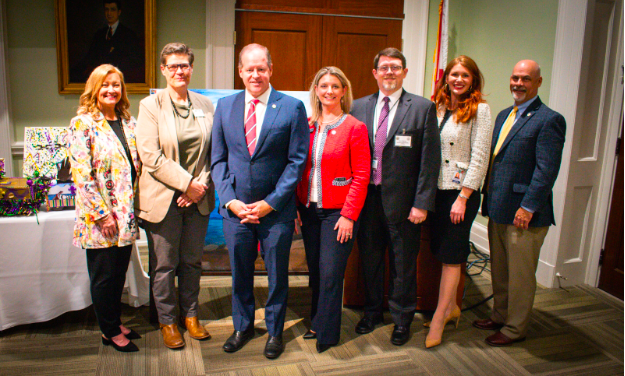
By: Hayley Richards
MONTGOMERY, Ala – The Alabama Bureau of Pardons and Paroles hosted its second annual ‘Changing the Course’ art exhibition at the Alabama Department of Archives and History (ADAH) at 624 Washington Ave. in Montgomery. The event showcases the art of formerly and currently incarcerated inmates. The exhibition was filled with over 100 art pieces including paintings, sculptures and welded murals. The detailed artwork often tells a story behind its creator. The event hosted several legislators, media outlets, ADAH staff and other members of the general public.
The exhibition is a joint effort between six state entities: the Alabama Bureau of Pardons and Paroles, the Alabama Department of Corrections, Auburn University’s Alabama Prison Arts Education Project, Ingram State Technical College, the Alabama Department of Archives and History, and the Alabama Department of Mental Health.
The entities involved in the program acknowledge the importance of art as an outlet for trauma and as a creative way to cope with anxiety. Art therapy is a tool therapists use to help patients interpret, express, and resolve their emotions and thoughts. Patients work with an art therapist to explore their emotions, understand conflicts or feelings that are causing them distress, and use art to help them find resolutions to those issues. For many inmates, being in a creative headspace allows an outlet for escaping their personal issues. While some artwork on display might appear simple, it often has a dark story behind it. Oftentimes inmates do have a way to express their emotions, but this program allows inmates to have a chance to feel human.
Formerly incarcerated artist Tameca Cole attended the event. Cole is a lifelong resident of Birmingham, Alabama, serving life on parole after spending 26 years in the Alabama Department of Corrections. In her artist statement, Cole quotes, “Art and writing allow me to address my personal demons in a way that doesn’t hurt others. It gives me an outlet to express how the cruelty of my incarceration, injustice, and experience with racism has affected me. It gives me the power to show other human beings how degrading it feels to be Black in America and still live under systemic racism.”
